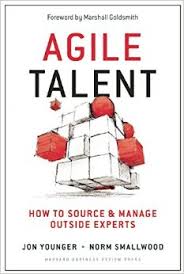by Theodore Kinni
Did you hear the one about the senior executive who didn’t think much of the external consultants hired for a project at his Fortune 100 company? He called them “insultants” in meetings in which they were present. Unsurprisingly, his staff picked up and echoed his attitude. The project failed.

Jon Younger and Norm Smallwood, respectively partner emeritus and president of RBL Group, a human resources consulting and development firm, tell this story in their new book, Agile Talent: How to Source and Manage Outside Experts (Harvard Business Review Press, 2016). Agile Talent is a book of particular interest to me for two reasons. First, I am one tiny drop in the ever-swelling ocean of external talent used by companies around the world. Second, on occasion, I have worked for corporate clients who seem hell-bent on getting less than what they are paying me for. This may sound improbable, but it’s happened often enough over the past 25 years that I now try to proactively identify such clients and avoid the lose-lose propositions they present — in my case, writing and editing assignments in which the client will not get full value and I will get agita.
Business leaders should care about these issues. For whether or not they think the economy of tomorrow will be a gig-driven one in which everyone is a freelancer, the corporate use of external talent across sectors and geographies is more common than ever. Younger and Smallwood tick off the reasons why: External talent can provide companies with access to new capabilities and technologies; it can enable faster and more agile response to markets; it can be used to test new opportunities before making major investments; it can be used to respond to demand peaks and to attain scale quickly; and, perhaps most commonly, it can reduce costs.
The problem, to which I can attest, is that most companies don’t have a system in place to ensure that they are optimizing their return on external talent. Instead, they treat external talent with the same narrow “you work, we pay you” mind-set that they abandoned long ago with their own full-time employees because of its negative effects on productivity, loyalty and retention, and quality and customer experience.
The solution, which Younger and Smallwood lay out in rather dry, academic terms in Agile Talent, requires applying many of the same kinds of recruiting and development programs most companies have in place for their internal talent to their external talent: strategic resourcing analysis; onboarding programs; development opportunities; etc. It seems to me that the authors get a little carried away in this regard, transforming the management of external talent into a full-blown functional silo. They suggest, for example, that companies consider appointing a “chief external talent officer.” But then, much of the prescriptive content in this book is aimed at senior human resource professionals in big companies that are using lots of external talent to attain strategic goals. If that describes you and your company, the authors’ advice may be entirely appropriate.
If, however, your company uses external talent to a lesser degree, Agile Talent will pose a bit more of a challenge. You may have to decipher the professional jargon and apply it on a smaller scale. But that would be well worth the effort, because any manager charged with overseeing external talent could improve the return on the company’s investment by adopting some simple practices based on Younger and Smallwood’s thinking.
One such practice would be to devote a bit of time to ensuring that the external talent working in your company understands the strategic context of the tasks they have been hired to conduct. Another would be to break down the “us versus them” wall that too often exists between employees and external talent. A third would be the provision of ongoing performance appraisals.
Regardless of the approach, companies should be taking a fresh look at how they manage external talent. Outsourcing should not mean out of sight and out of mind.
![]()
![]()
![]()
![]()
![]()
![]()
![]()















